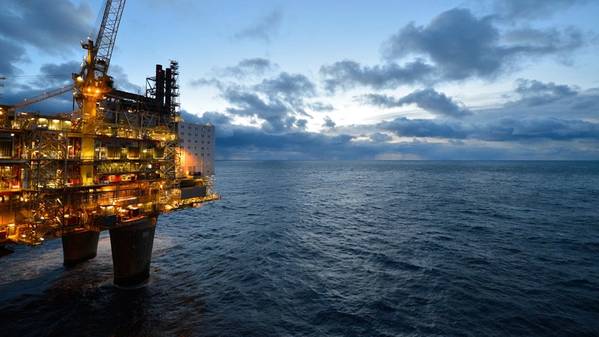
Norwegian oil and gas company Equinor has with its partners, submitted an amended plan for development and operation (PDO) to the minister of petroleum and energy Marte Mjøs Persen for the further development of the Oseberg field, with an increased focus on gas production. The total investment will amount to NOK 10 billion (around USD $1,1 billion).
Equinor said that the Oseberg Area Unit partners will reduce CO2 emissions from the Oseberg Field Centre and the Oseberg South platform while increasing Oseberg gas production.
Oseberg will be developed from primarily being an oil field to becoming a substantial gas producer with large remaining gas resources, Equinor said.
Two new compressors will be installed to boost recoverable gas volumes and the Oseberg Field Centre and Oseberg South platform will be partially electrified.
"It is important to Equinor and the Oseberg partners to produce oil and gas with the lowest possible emission level. This investment decision allows us to increase production of Oseberg gas considerably in the future, while reducing CO2 emissions by an estimated 320,000 tonnes per year. During the project planning we have received good support from and cooperated closely with our partners. We are now entering the execution phase together with highly qualified suppliers,” says Geir Tungesvik, Equinor’s senior vice president for project development.
New facility in 2026
Equinor said that the work to be carried out on the platforms is extensive as three big modules totaling 3400 tonnes will be installed.
"Rebuilding of the Oseberg Field Centre will take four years and give work to 70 people. On Oseberg South, 40 people will be occupied for one year. This will be done while the plants are in full operation and will require close and good cooperation between all the different players," Equinor added.
Per Equinor, Oseberg is the third-largest oil producer ever on the NCS. When Oseberg came on stream, it was expected to produce around one billion barrels of oil.  File image: Equinor
File image: Equinor
"Today we expect the field to produce a total of around 3.2 billion barrels of oil. Oil production is in the tail phase, but 60 per cent of the gas resources are still in the ground. When it comes to gas, Oseberg is also one of the major fields, only Troll and Snøhvit have more remaining gas resources on the NCS," Equinor added.
“With this investment, we open a new chapter of the story of Oseberg, which is about to become one of the main Norwegian gas producers. We expect Oseberg to produce more than 100 billion sm3 of gas towards 2040. In terms of energy, the annual gas export from Oseberg will equal a quarter off all Norwegian hydropower,” says Geir Sørtveit, Equinor’s senior vice president for exploration and production west.
Licence partners are Equinor Energy AS (operator) 49.3%, Petoro AS 33.6%, TotalEnergies EP Norge AS 14.7%, ConocoPhillips Skandinavia AS 2.4%.
Power from shore cuts emissions
According to the Norwegian oil firm, for the year 2020, Oseberg emissions totaled around one million tonnes of CO2.
"Since 2010, emissions at Oseberg have been reduced by around 15 percent, and there is an ambition of further reducing emissions by 50-70 per cent by 2030. The new compressors and electrification from shore is vital to reach this ambition," the company said,
“If the world is to reach its net zero emission goal, we must remove emission sources, also on the NCS. Electrification is an effective climate action as it involves large and swift emission cuts. The solution adopted gives a cut in emissions of about 50 per cent from the Oseberg Field Centre and the Oseberg South platform, representing an important move to continue the long-term value creation from the Oseberg area,” adds Sørtveit.
In March 2021, Equinor obtained a licence from the Ministry of Petroleum and Energy (MPE) to construct, own and operate necessary electrical facilities to provide the Oseberg Field Centre and the Oseberg South platform with power from shore. Oseberg will have a total power demand of up to 105 MW. The project will also prepare for any full electrification of the installations in the future, Equinor added.
70% of work to be carried out by Norwegian companies
Equinor said that 70 percent of investments in the Oseberg upgrades will go to suppliers in Norway.
Aibel has won the contract for engineering, procurement, construction, and installation (EPCI) for partial electrification of the Oseberg Field Centre and Oseberg South, as well as upgrading of the gas processing capacity on the Oseberg Field Centre.
The scope of work includes electrical installations in a new substation at Kollsnes. The contract is valued at more than NOK four billion and Aibel estimates the work to require around 1300 person-years. Three modules will be constructed at Aibel’s yard in Haugesund, and most of the engineering and management will be carried out at Aibel’s office in Bergen, supported by their offices in Stavanger and Oslo.
Nexans has been awarded a framework contract by Equinor for delivering subsea power cables and their first assignment will be to deliver a 132 km cable for Oseberg. The cables will be fabricated in Halden and are scheduled to be installed by Nexan’s new «Nexans Aurora» vessel in 2023. The contract value is calculated at more than NOK 800 million.
Heerema Marine Contractors has been awarded a contract for transport and installation at an estimated value of NOK 60 million. In the summer of 2024, the «Sleipnir» vessel is scheduled for lifting in place the three big modules currently under construction at Aibel’s yard in Haugesund.
Skanska Norge AS has been awarded a contract for construction of a substation, cable trenches and landfall at Kollsnes. This contract is a cooperation with the Troll West electrification project.
The contracts are subject to government approval of the plan for development and operation.



